Humans are well-known for being a social species, but did you know that there are also many other animals that live and travel in packs as well. They do this for many reasons — safety in numbers being a big one! But did you know that they also form social bonds with each other? Just like humans form relationships with their friends and family.
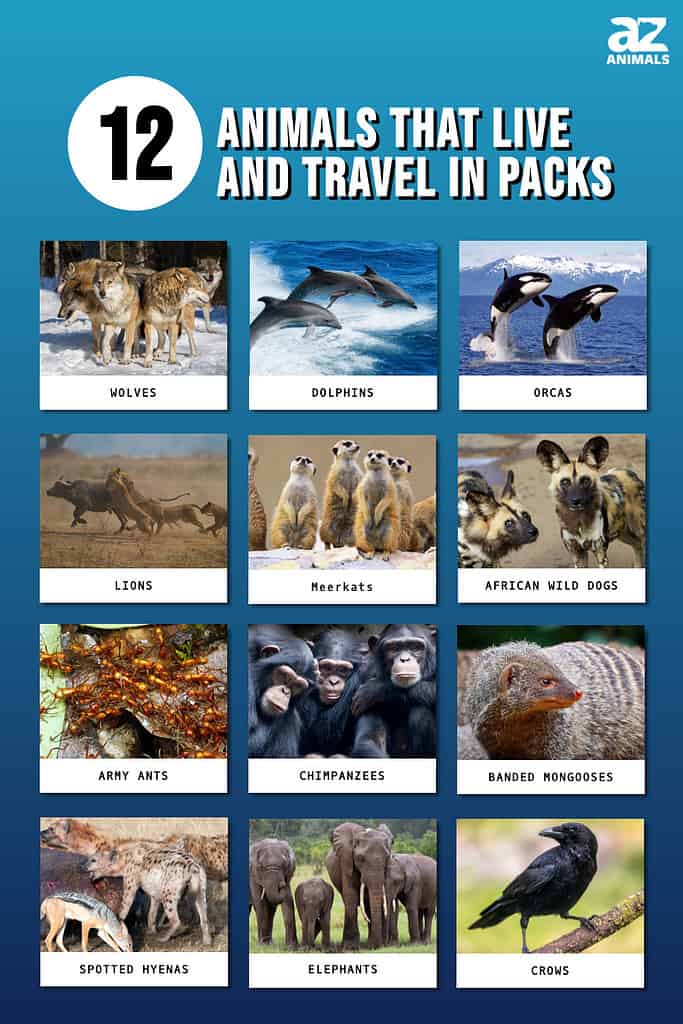
From wolves to army ants, let’s take a look at 12 of these animals and see how they benefit from living and traveling in groups.
1. Wolves
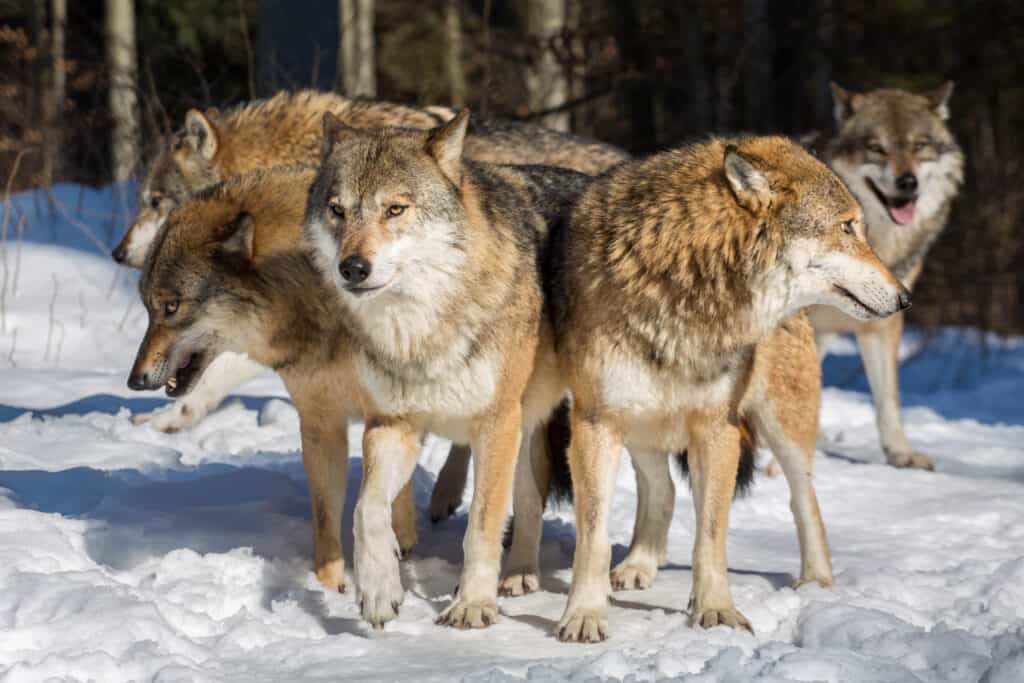
A wolf pack is structured with a complex social hierarchy, with the alpha wolves leading the pack.
©David Dirga/Shutterstock.com
Of course, we had to start with wolves — these are probably the most iconic animals that live and travel in packs. These famously social creatures live, travel, and hunt in packs of anywhere from two to 30 members. A wolf pack is structured with a complex social hierarchy, with the alpha wolves leading the pack. And while each wolf has its own personality and role within the pack, they’re all fiercely loyal to one another — so much so that if a member of the pack dies or goes missing, the remaining wolves will search for them until they’re reunited.
Living in a pack provides companionship as well as protection from predators. However, the pack’s cooperation and teamwork truly shine during a hunt. Each wolf has an important part to play when hunting, whether it is the younger wolves who observe and learn from a distance, the speedy wolves that herd and confuse the prey, or the slow but powerful wolves that ultimately attack the animal.
2. Dolphins

Dolphins benefit from living in groups, and they have greater success hunting for food and fending off predators.
©IgorZh/Shutterstock.com
A pack or “pod” of dolphins can range from just a few to hundreds of individuals. Like wolves, dolphins benefit from living in groups; they have greater success hunting for food and fending off predators. Dolphins work together in their pod to surround and corral fish, often swimming in a line and slapping their tails against the water’s surface. This causes vibrations that scare the fish into moving toward shallow waters where the dolphins can easily catch them for food!
This cooperative behavior shows just how intelligent dolphins are when traveling in packs. But, of course, this also requires some amazing communication skills. To communicate, dolphins use a variety of noises, including whistles, clicks, and squeaks that can travel up to two miles! These noises help them stay in contact with each other while searching for food or swimming together. They also have an incredible ability to recognize one another by using their own individual vocal signatures.
3. Orcas

Orcas are very social creatures that live and travel in packs of up to 40 individuals called “pods.”
©slowmotiongli/Shutterstock.com
Also known as killer whales, orcas can weigh 6 to 8 tons and grow over 25 feet long. Despite their large size, orcas are very social creatures that live and travel in packs of up to 40 individuals called “pods.” Because they are such large animals, orcas need a lot of food to survive. They travel in groups so that they can share in the bounty (and work) of hunting and gathering food.
Additionally, living in these generational groups allows orcas to share important information with each other. For example, orcas have been known to pass down information about where to find food. They have also been observed helping sick or injured members of their pod. Orcas communicate with each other using a variety of vocalizations, including clicks, whistles, and screams.
4. Lions
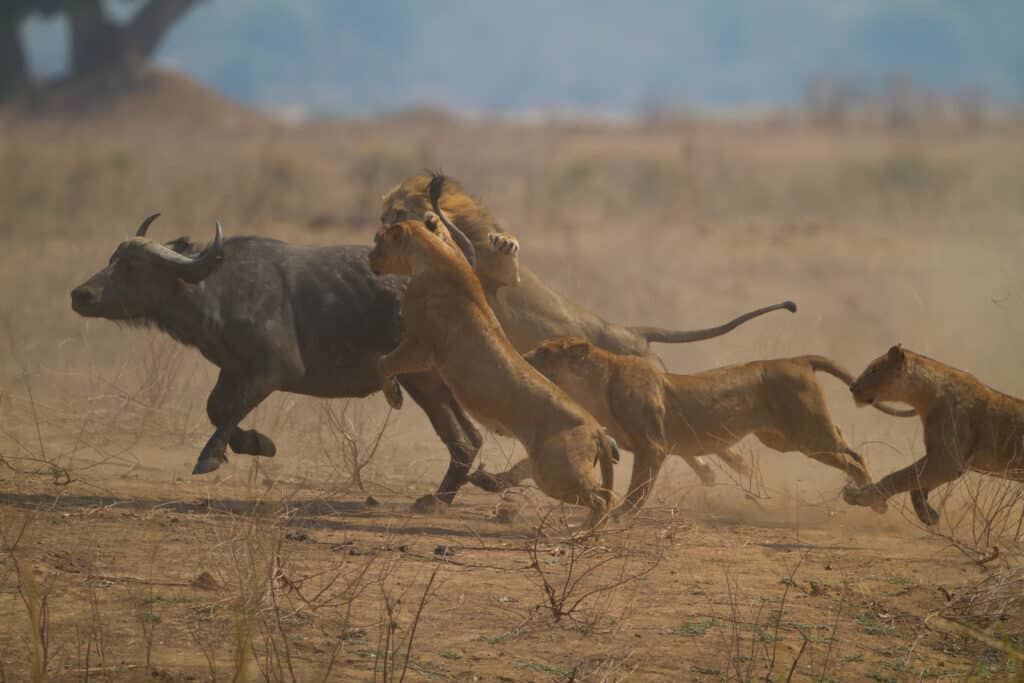
Lionesses far outnumber the unrelated male lions in a pride, and they take charge of hunting most of the time.
©Jez Bennett/Shutterstock.com
They might be considered the “Kings of the Jungle,” but even lions know the benefits of living and traveling in packs. Lions are social creatures, living in packs called “prides” that typically consist of 15-20 individuals but could have up to 40. Although both male and female lions play an important role in the pride, it is usually dominated by related lionesses. Lionesses far outnumber the unrelated male lions in a pride, and they take charge of hunting most of the time.
Of course, living in a group isn’t always easy — even for lions. For example, pride members compete with one another for food and mates, sometimes leading to fighting and even death. However, the benefits of living in a pride usually outweigh the disadvantages when it comes to surviving and reproducing.
5. Meerkats

Meerkat packs are structured in a social hierarchy.
©Zsolt Biczo/Shutterstock.com
Living in packs of three to 25 individuals, meerkats are small, social creatures that live in the desert regions of southern Africa in underground burrows. These animals display cooperative behaviors and demonstrate how even the smallest of creatures can exhibit complex behaviors.
Meerkat packs, also called “mobs,” are structured in a social hierarchy, although members often take turns completing certain jobs, such as caring for the young of the group. These small animals are extremely watchful and take turns acting as sentries for the group to keep an eye out for danger. Sentries will alert the group using a wide variety of different vocal sounds and barks.
6. African Wild Dogs
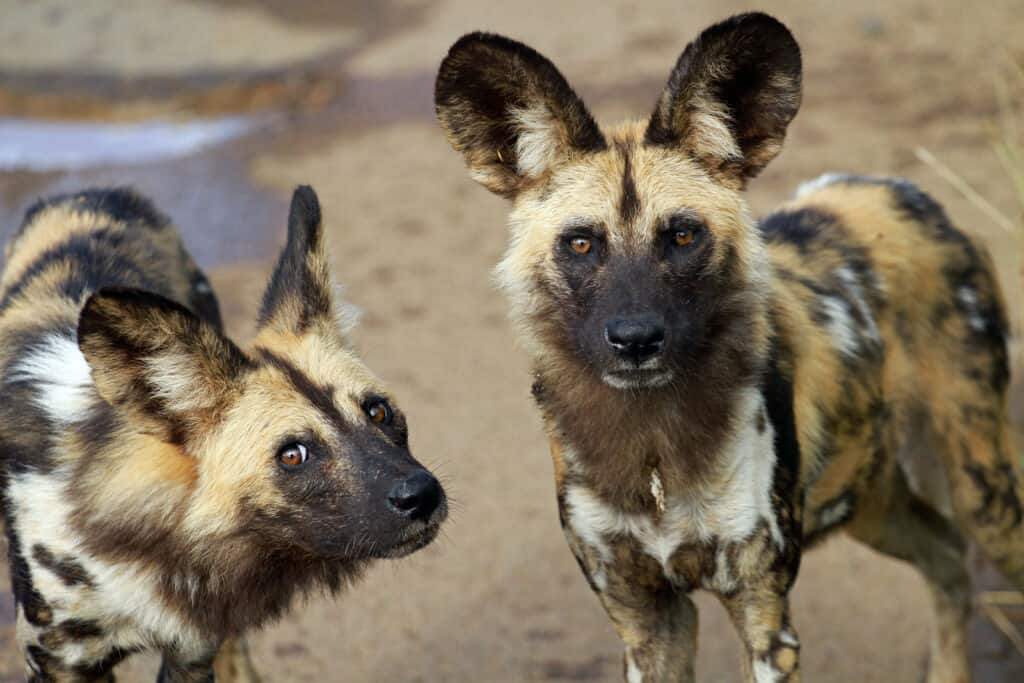
African wild dogs are known to prey on animals that are significantly larger than they are, such as
antelope
and zebra.
©bayazed/Shutterstock.com
Native to sub-Saharan Africa, African wild dogs are sometimes called African painted dogs or cape hunting dogs. No matter what you call them, one thing is for sure: these animals know how to live in harmony with their fellow pack members. The entire pack of wild dogs works together to take down their prey. This is no small feat, as African wild dogs are known to prey on animals that are significantly larger than they are, such as antelope and zebra. Once the prey has been brought down, the dogs will eat their fill before moving on.
Because they rely heavily on teamwork, African wild dogs have a very sophisticated communication system. In fact, these painted dogs are some of the most social canids on earth! They use numerous vocalizations to communicate greetings, danger, PLAYTIME (yes, that last one was all caps because it’s very important), and more.
7. Army Ants
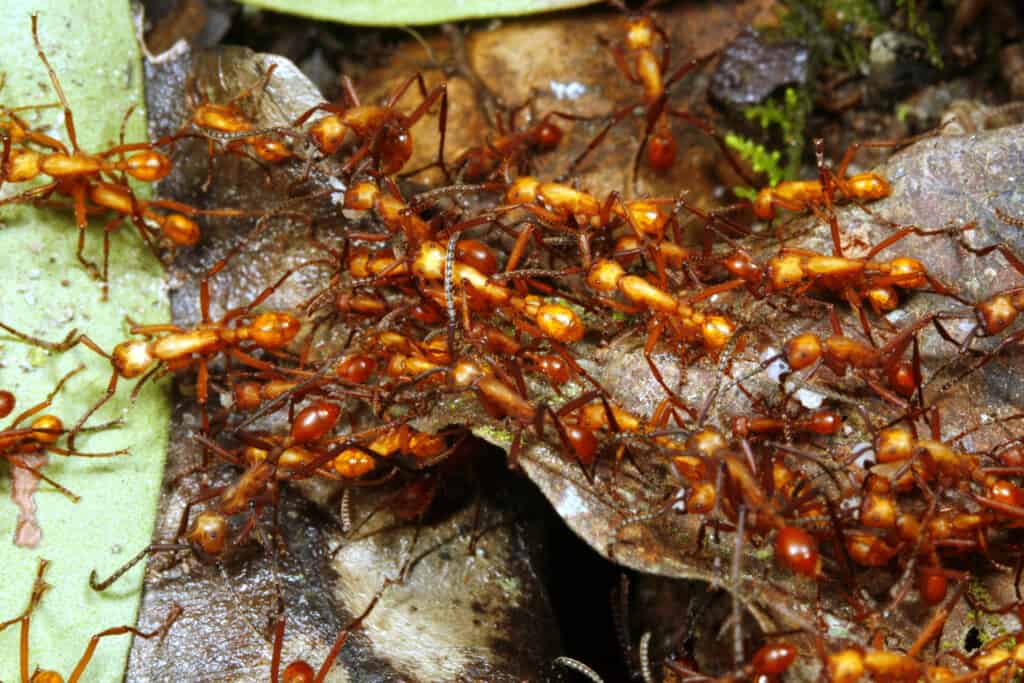
Army ants are aggressive predators that will eat just about anything in their path, including other insects and small vertebrates.
©Dr Morley Read/Shutterstock.com
These ants aren’t like the pesky variety that invades your picnic basket; they are army ants, and they travel in massive groups numbering in the millions. Army ants are aggressive predators that will eat just about anything in their path, including other insects and small vertebrates. When an army ant colony needs to move to a new location, the ants will join their bodies together to form a living bridge. This bridge allows the entire colony to safely cross over any obstacles in their path, such as rivers or ravines.
A pack of army ants comprises three types of ants: soldiers, workers, and the queen. The soldiers protect the queen and the pack. The workers are responsible for gathering food for the colony, and the queen’s only job is to lay eggs. This division of labor ensures that the pack runs smoothly and everyone has a specific purpose.
8. Chimpanzees
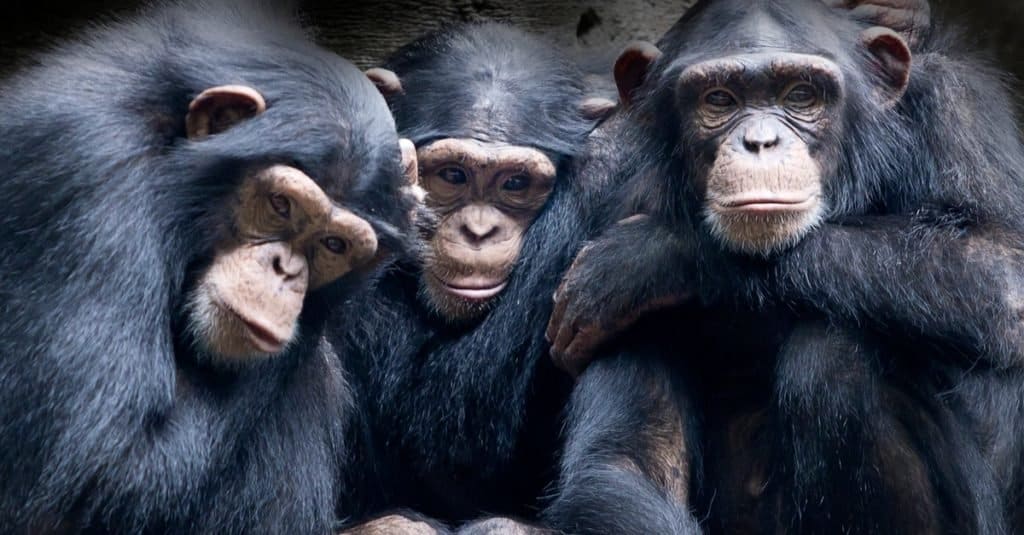
Packs of chimpanzees have a strict, patriarchal structure dominated by males in the group.
©Lili Aini/Shutterstock.com
Known for their close-knit social bonds, chimpanzees live in social groups that contain between 15 and 150 chimps. Packs of chimpanzees have a strict, patriarchal structure dominated by males in the group. Male chimps often make alliances and coalitions with other males to increase their rank. However, this hierarchy is often unstable, and betrayals are common.
Within the larger group, the chimps are also organized into smaller “subgroups” with specific jobs, although these groups can be temporary and shift over time. When chimpanzees travel in packs, they can cover more ground and find more food sources than they could on their own. However, sometimes competition for food can be fierce. If there is not enough food to go around, tensions can flare, and fights can break out among members of the group.
9. Banded Mongooses
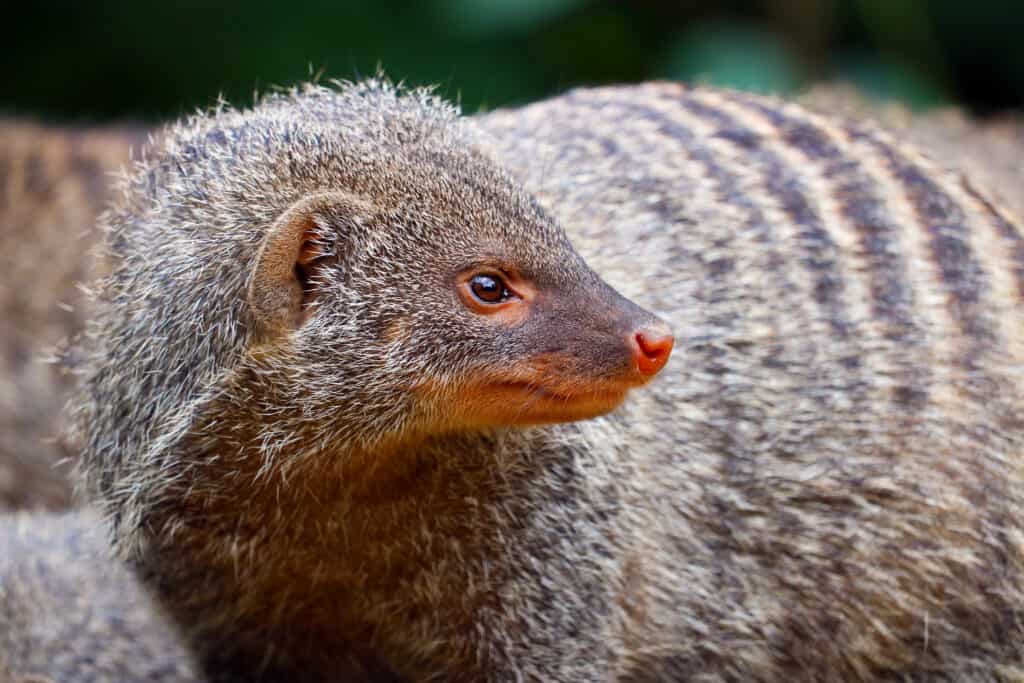
Banded mongooses live together in packs of seven to 40 individuals with a complex social structure.
©markusmayer/Shutterstock.com
Unlike many other mongoose species, banded mongooses live together in packs of seven to 40 individuals with a complex social structure. Aggression in these packs is surprisingly low, and their hierarchies are not very strict. However, a pack of mongooses can be territorial, and aggression between different groups can be violent and even lead to death.
Although individuals forage independently, mongoose packs stick together when searching for food. They constantly communicate with one another, using scent cues and low grunts to check-in. If the group encounters a threat, the mongooses will band together in their pack to fight it off. In addition, group members work together to care for the young in the group, often babysitting when pack members are sent out to forage for food.
10. Spotted Hyenas
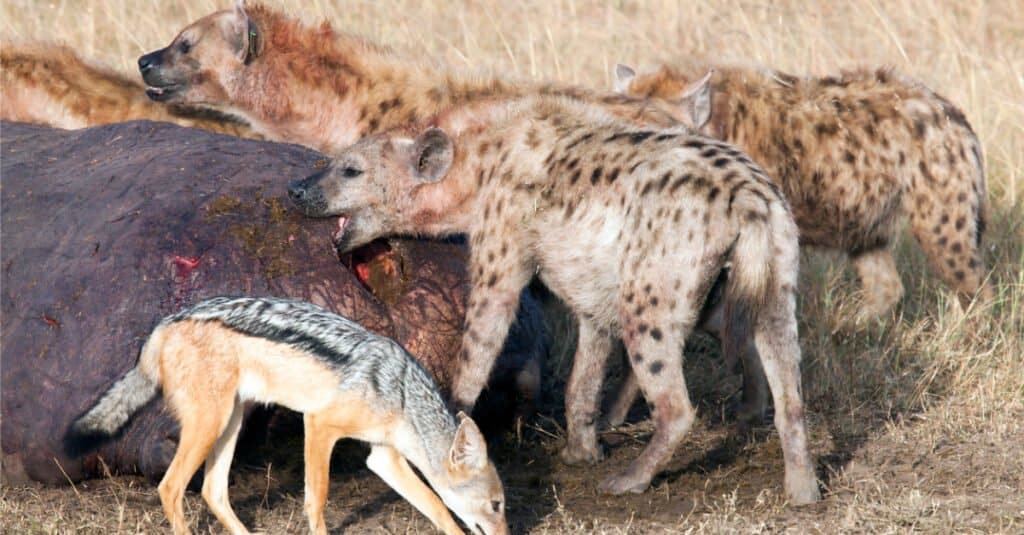
Spotted hyenas use multiple senses to communicate and understand each other.
©iStock.com/Angelika
Living in sub-Saharan Africa, the spotted hyena has evolved to work together in packs and has an extremely complex social structure. A rather unique aspect of hyena groups is that their hierarchy is matriarchal and led by the larger females. However, unlike other animals on this list, spotted hyenas are much more competitive than cooperative. For example, female hyenas only care for their biological young rather than forming nursery groups to support the pack.
A pack of hyenas, called a “clan,” consists of up to 80 individuals. Spotted hyenas use multiple senses to communicate and understand each other. They can also tell which clan-mates they can trust and which ones they should be careful around. The social network of spotted hyenas is often determined by the environment (like how much it rains or how many animals there are to eat) and individual preferences within the pack — such as whether they want to be around females or other family members.
11. Elephants
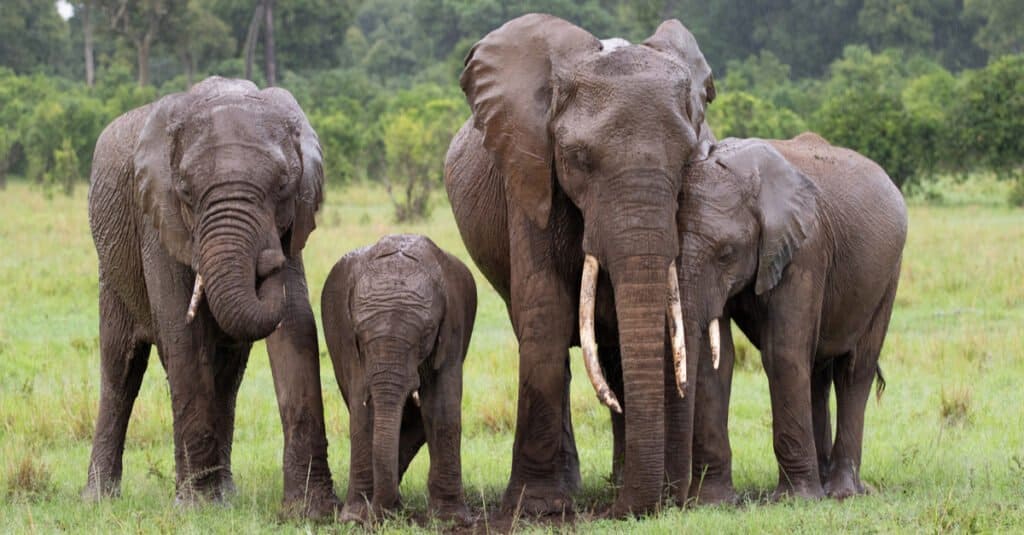
Elephants are very intelligent and social creatures.
©Neil Tyers/Shutterstock.com
A pack of elephants, also called a herd, typically has 10 to 12 individuals, but some may have as many as 100! Elephants are social creatures that live in close-knit family groups consisting of mothers, daughters, aunts, and cousins. When one member of the herd is threatened, the others will quickly come to its aid. And if an elephant gets separated from the group, the pack will do everything they can to find it and bring it back. The oldest and most experienced female — known as the matriarch — leads the herd. The matriarch is responsible for finding food and water and identifying safe habitats.
But protection isn’t just about warding off predators; it’s also about providing emotional support. Elephants are very intelligent and social creatures, and their close-knit families provide them with emotional support, comfort, and companionship throughout their long lifespans. In fact, studies have shown that elephants experiencing high levels of stress will seek out members of their herd that they know will provide them with solace and support.
12. Crows

Crows are very cooperative within their groups.
©Rudmer Zwerver/Shutterstock.com
Known for their high levels of intelligence (and sometimes mischief), crows are among the smartest animals in the world. They are also highly social creatures that live and travel in packs. Crows typically live in groups of 10 to 20 birds, but some crow populations can number in the hundreds or even thousands. Crow packs function similarly to wolf packs: the pack works together to find food and protect each other from predators.
Crows are very cooperative within their groups. They work together to find food sources and help feed and care for young chicks. Crows also band together to “mob” predators and other threats to chase them away from the group. When a crow dies, the other members of the pack will surround the body and use their beaks to poke at it. While it appears that the crows are hosting a funeral, scientists believe that they are actually trying to discern what killed the deceased crow so that they can learn about potential dangers in their environment.
Bonus: Is a Cheetah Coalition the Same as a Pack?

Cheetahs form groups of 2 – 5 individuals to form a coalition.
©Stolz, Gary M., U.S. Fish and Wildlife Service, Public domain, via Wikimedia Commons – License
Cheetahs don’t usually come to mind when you think about animals that live in packs – but they do form small groups called coalitions that play an important role in cheetah society. Most female cheetahs are solitary except when mating and raising their cubs – but males form hunting groups. These small groups of two to five cheetahs live and hunt together and often form tight bonds. Some members may join temporarily but most of the time they stay united for life! Females join a coalition on occasion – but most of the time it is a brotherhood. Being in a coalition helps them to defend territory, hunt prey and attract mates. Siblings often form the core of these groups but they don’t have to be related to join. Cheetah coalitions are affectionate with each other and have each other’s backs in a tough, competitive environment. It’s not quite a pack – but almost!
Summary of the 12 Animals That Live and Travel in Packs
| Rank | Animal |
|---|---|
| 1 | Wolves |
| 2 | Dolphins |
| 3 | Orcas |
| 4 | Lions |
| 5 | Meerkats |
| 6 | African Wild Dogs |
| 7 | Army Ants |
| 8 | Chimpanzees |
| 9 | Banded Mongooses |
| 10 | Spotted Hyenas |
| 11 | Elephants |
| 12 | Crows |
The photo featured at the top of this post is © bayazed/Shutterstock.com
Sources
- ProQuest, Available here: https://www.proquest.com/openview/ea0533f1134c4583afce1a2318534c05/1?pq-origsite=gscholar&cbl=38594
- Cambridge University Press, Available here: https://www.cambridge.org/core/journals/journal-of-zoology/article/abs/patterns-of-coalition-formation-and-spatial-association-in-a-social-carnivore-the-african-wild-dog-lycaon-pictus/9A8FEB4D03B0D2B04076192CE290E2F4
FAQs (Frequently Asked Questions)
What is a pack animal?
A pack animal is actually different than an animal that travels in a pack (although some of them do travel in packs as well). A pack animal is an animal that carries cargo or other items on its back. The most common types of pack animals are horses, mules, donkeys, camels, yaks, llamas, and caribou. Aside from carrying goods, pack animals can also be trained for riding or used for recreation or therapy purposes. Additionally, they do not damage the environment like motorized vehicles can.
What are the benefits of traveling in a pack?
Animals travel in packs for many reasons, but one of the most important benefits is protection. Being part of a pack increases the safety of an animal, because with more animals there are more eyes on the lookout for potential predators or other dangers. Traveling in a pack also allows animals to cover more ground and search for food sources over a larger area than they could on their own. This can be especially helpful when resources are scarce. Additionally, being part of a pack allows animals to share knowledge and experience with each other, which can help them better survive in their environment. Finally, traveling in packs helps animals build bonds and form connections with others in their species that are essential for social well-being.
Are there any disadvantages to traveling in a pack?
Yes, there are some potential disadvantages to traveling in a pack of animals. For one, it can be harder to find food if multiple animals are trying to feed from the same area. Animals may also have difficulty finding shelter or suitable sleeping areas as they all try to fit into one spot. Additionally, packs of animals often attract predators due to the large amount of noise and movement they produce. And if one animal gets sick, the disease can travel through the pack quickly. Finally, pack members may fight over resources such as food or sleeping spots, further compromising their safety and survival.
Thank you for reading! Have some feedback for us? Contact the AZ Animals editorial team.






